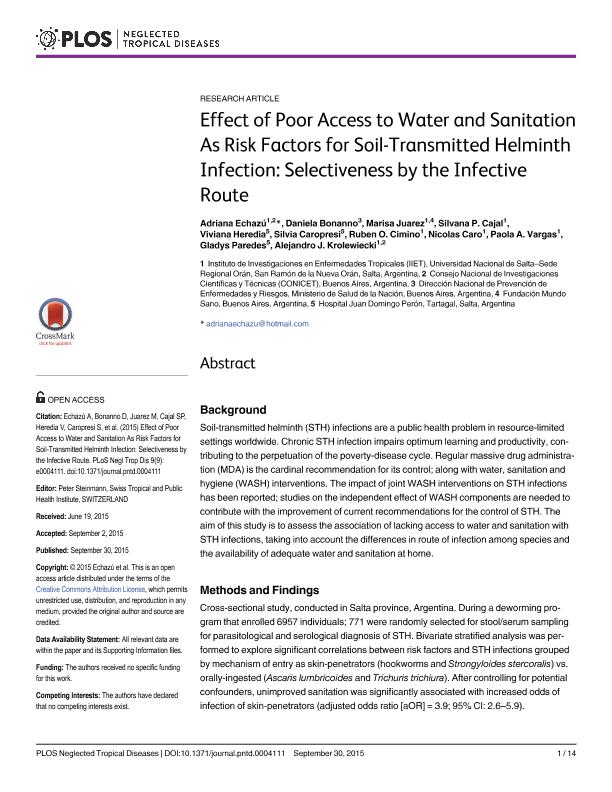Artículo
Effect of Poor Access to Water and Sanitation As Risk Factors for Soil-Transmitted Helminth Infection: Selectiveness by the Infective Route
Echazú, Adriana ; Bonanno, Daniela; Juarez, Marisa; Cajal, Silvana Pamela; Heredia, Viviana Ines; Caropresi, Silvia; Cimino, Rubén Oscar
; Bonanno, Daniela; Juarez, Marisa; Cajal, Silvana Pamela; Heredia, Viviana Ines; Caropresi, Silvia; Cimino, Rubén Oscar ; Caro, Nicolas; Vargas Flores, Paola Andrea
; Caro, Nicolas; Vargas Flores, Paola Andrea ; Paredes, Gladys; Krolewiecki, Alejandro Javier
; Paredes, Gladys; Krolewiecki, Alejandro Javier
 ; Bonanno, Daniela; Juarez, Marisa; Cajal, Silvana Pamela; Heredia, Viviana Ines; Caropresi, Silvia; Cimino, Rubén Oscar
; Bonanno, Daniela; Juarez, Marisa; Cajal, Silvana Pamela; Heredia, Viviana Ines; Caropresi, Silvia; Cimino, Rubén Oscar ; Caro, Nicolas; Vargas Flores, Paola Andrea
; Caro, Nicolas; Vargas Flores, Paola Andrea ; Paredes, Gladys; Krolewiecki, Alejandro Javier
; Paredes, Gladys; Krolewiecki, Alejandro Javier
Fecha de publicación:
09/2015
Editorial:
Public Library of Science
Revista:
Neglected Tropical Diseases
ISSN:
1935-2735
Idioma:
Inglés
Tipo de recurso:
Artículo publicado
Clasificación temática:
Resumen
Background: Soil-transmitted helminth (STH) infections are a public health problem in resource-limited settings worldwide. Chronic STH infection impairs optimum learning and productivity, contributing to the perpetuation of the poverty-disease cycle. Regular massive drug administration (MDA) is the cardinal recommendation for its control; along with water, sanitation and hygiene (WASH) interventions. The impact of joint WASH interventions on STH infections has been reported; studies on the independent effect of WASH components are needed to contribute with the improvement of current recommendations for the control of STH. The aim of this study is to assess the association of lacking access to water and sanitation with STH infections, taking into account the differences in route of infection among species and the availability of adequate water and sanitation at home. Methods and Findings: Cross-sectional study, conducted in Salta province, Argentina. During a deworming program that enrolled 6957 individuals; 771 were randomly selected for stool/serum sampling for parasitological and serological diagnosis of STH. Bivariate stratified analysis was performed to explore significant correlations between risk factors and STH infections grouped by mechanism of entry as skin-penetrators (hookworms and Strongyloides stercoralis) vs. orally-ingested (Ascaris lumbricoides and Trichuris trichiura). After controlling for potential confounders, unimproved sanitation was significantly associated with increased odds of infection of skin-penetrators (adjusted odds ratio [aOR] = 3.9; 95% CI: 2.6–5.9). Unimproved drinking water was significantly associated with increased odds of infection of orally-ingested (aOR = 2.2; 95% CI: 1.3–3.7). Conclusions: Lack of safe water and proper sanitation pose a risk of STH infections that is distinct according to the route of entry to the human host used by each of the STH species. Interventions aimed to improve water and sanitation access should be highlighted in the recommendations for the control of STH.
Palabras clave:
Access
,
Water
,
Sanitation
,
Heminth
Archivos asociados
Licencia
Identificadores
Colecciones
Articulos(CCT - SALTA-JUJUY)
Articulos de CTRO.CIENTIFICO TECNOL.CONICET - SALTA-JUJUY
Articulos de CTRO.CIENTIFICO TECNOL.CONICET - SALTA-JUJUY
Articulos(IPE)
Articulos de INST.DE PATOLOGIA EXPERIMENTAL
Articulos de INST.DE PATOLOGIA EXPERIMENTAL
Citación
Echazú, Adriana; Bonanno, Daniela; Juarez, Marisa; Cajal, Silvana Pamela; Heredia, Viviana Ines; et al.; Effect of Poor Access to Water and Sanitation As Risk Factors for Soil-Transmitted Helminth Infection: Selectiveness by the Infective Route; Public Library of Science; Neglected Tropical Diseases; 9; 9; 9-2015; 1-14; e0004111
Compartir
Altmétricas



